| |

|
| |
| HCP Engagement |
| The COVID bounce sees virtual meetings stick |
| Source: Indegene |
A new report from Indegene looks at the channels pharma uses to communicate with HCPs. |
|
COVID Bounce
|
| |
The COVID bounce wreaked havoc on in-person contacts, but they are now largely back (2) and conferences have squeaked by face-to-face Rep visits (1). The virtual meeting has remained sticky (3) post-COVID (it's not over yet -Ed.): |
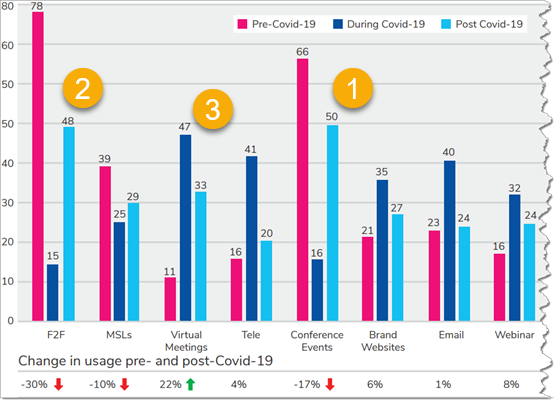
|
|
Image adapted for email from Indegene source
|
| |
|
Omnichannel Outperforms
|
| |
In the report it shows a calculation that purports to calculate the best channel mix for a brand. While laudable, it seems to rely on a factor not easily measured "β is the relative impact of each channel toward new sales." Regardless, when they compared different omnichannel mixes to simple face-to-face with a rep only one digital-only mix made it above the line: |
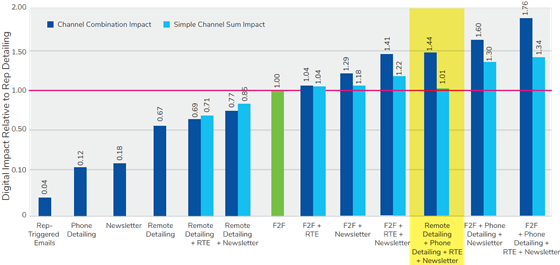
|
|
Image adapted for email from Indegene source
|
| |
It's hard to read, but "Remote Detailing + Phone Detailing + Rep-Triggered Emails + Newsletter" made the cut. Notice that F2F always benefited from other channels for that omnichannel "surround sound." |
There is also some data from the Digitally-Savvy HCP from 2021 reprised in the report. Definitely worth a look for HCP marketers. |
—
Read the full story from Indegene |
| |
|
|
|
|
| |

|
| |
| Market Research |
| HCPs want data & expertise |
| Source: World of DTC Marketing |
Richard Meyer over at the World of DTC Marketing blog says the group finished talking with 200 HCPs (we wonder if there will be a report on that activity). Two of the insights they bring back highlight doctors' thirst for data. |
|
Just the Data, Please
|
| |
Meyer makes the point that doctors don't want your fancy charts, they want to see the data for themselves and have the time to study it. |
Trust in pharma did not decline, but they don’t want to be told about the data via charts; they want the ability to read the data for themselves and talk to other HCPs about the data and drug. |
| |
|
MSLs Get Respect
|
| |
While reps might have a hard time getting access, doctors do want access to brand MSLs. |
However, it seems that medical liaisons provide a lot of the value supplied [sic] they have some type of medical background and can talk to them peer to peer. They want more access to medical liaisons, including talking with them via video chats and email. |
| |
We hope there will be a more formal report, but even these insights are valuable for pharma marketers looking to improve their digital contact points with their HCP audiences. |
—
Read the full story from World of DTC Marketing |
| |
|
|
|
|
| |

|
| |
| HCP Opinions |
| Top three satisfiers for HCPs are emotional rewards |
| Source: Medscape |
|
Emotional Rewards
|
| |
The survey doesn't just focus on pay, however. It also asks about other elements of the job. When asked about the most rewarding aspects of being a doctor, respondents started out with patient relationships: |
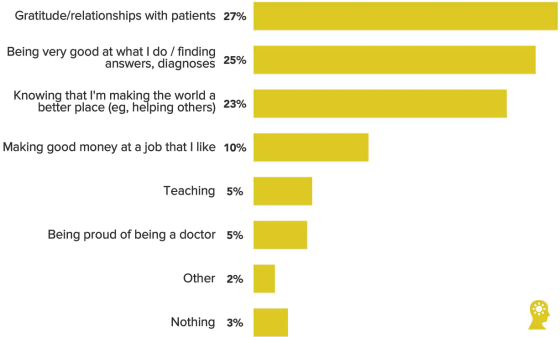
|
|
Image adapted for email from Medscape source
|
| |
|
Nothing's Perfect
|
| |
No job is perfect, however. Even if the average salary in 2022 is $368K for specialists there are still dissatisfiers: |
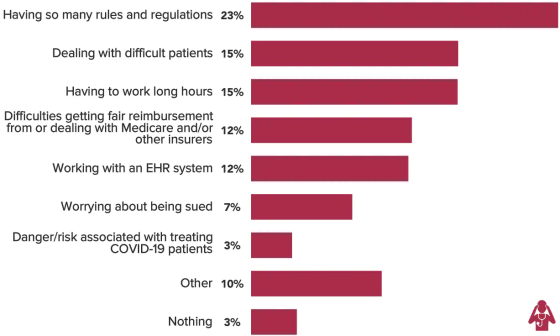
|
|
Image adapted for email from Medscape source
|
| |
|
Paperwork Eats Time
|
| |
The first dissatisfier, rules and regulations, often means one thing: paperwork. When asked how many hours per week they spent on paperwork, infectious disease specialists were almost at 20 hours: |
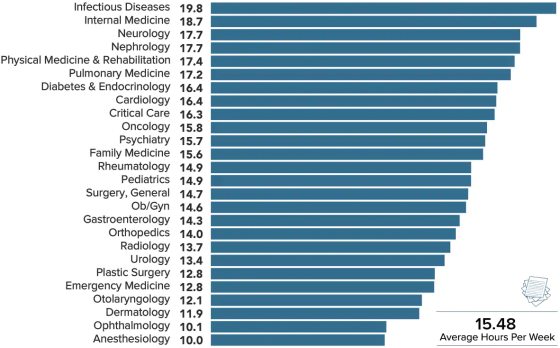
|
|
Image adapted for email from Medscape source
|
| |
So physicians love having relationships with patients, but spend a lot of time with paperwork and other tasks. Pharma doesn't have direct control over this but showing some empathy with their situation will go a long way to building a connection. |
If you want to see the actual salary breakdowns and other data head on over to the Medscape slideshow. |
—
Read the full story from Medscape |
| |
|
|
|
|
| |

|
| |
| Prepare your PSP for the Future |
|
|
The industry invests $14 billion per year on patient support services… is your investment paying off? Download this POV to find out more about how to empower your PSP to generate important outcomes evidence and ensure you are realizing the full potential of your investment. |
| |
|
Download POV
|
|
|
|
|
| |

|
| |
| Insights |
| Email and social win for ecommerce |
| Source: Cheetah Digital |
Cheetah Digital worked with Econsultancy and created a massive study of global consumers. This data is valuable just on its own but the authors also broke out everything by region, and included raw results in the appendix. Kudos to the folks at Cheetah for this. |
|
Email and Social for eCommerce
|
| |
Both email and social were popular with US consumers for online purchases. When asked if they had purchased from these sources the younger crowd said social and the older said email: |

|
|
Image adapted for email from Cheetah Digital source
|
| |
In the report the authors try to paint social in a bad light and claim that US consumers are moving away from the platforms. While there is public discussion about social, usage has only increased and the net results still seem positive. Also, when you ask consumers if they trust most digital sources they say no, but if you ask if they use them they say yes. |
|
Mobile is Big in eCommerce
|
| |
When asked if they had conducted these mobile activities, US respondents said yes. Mobile in-app purchases were strong as was in-store research when looking at products. |

|
|
Image adapted for email from Cheetah Digital source
|
| |
|
Loyalty Drivers
|
| |
In a separate webinar based on the data, the company discussed US-based data on loyalty programs. Some of the satisfiers for these programs were: |

|
|
Image adapted for email from Cheetah Digital source
|
| |
|
Loyalty Dissatisfiers
|
| |
Balancing out the drivers were the dissatisfiers in loyalty programs. Misaligned content was number one highlighting that if you collect preferences you should really act on them: |

|
|
Image adapted for email from Cheetah Digital source
|
| |
This report and webinar have good general consumer data for the US market. While we don't really put a lot of faith in consumers when they talk about trust, because convenience almost always wins, we do like the full data release that Cheetah includes. |
—
Read the full story from Cheetah Digital |
| |
|
|
|
|
| |

|
| |
| Mobile |
| Mobile app time up 25% in US |
| Source: data.ai |
The pandemic has driven more digital engagement on both desktop and mobile platforms. This data from data.ai (was App Annie) shows the growth of in-app time on mobile devices by country (Android only). |
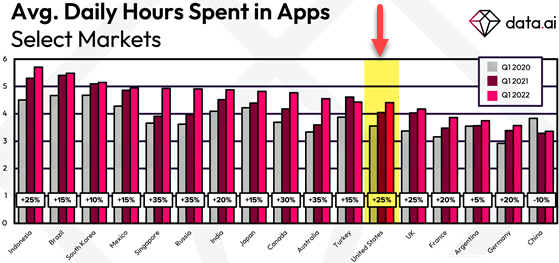
|
|
Image adapted for email from data.ai source
|
| |
Between Q1 2020 and Q1 2022 the US has seen 25% growth on an already near-saturated number. |
—
Read the full story from data.ai |
| |
|
|
|
|
| |

|
| |
| Metaverse |
| 41% of executives overestimate the metaverse |
| Source: eMarketer |
We're just saying it, the metaverse isn't here yet. A report from Accenture, reported in eMarketer, shows many C-suite executives think the metaverse will have a positive impact on their companies, ranging from minimal to transformational: |

|
|
Image adapted for email from eMarketer source
|
| |
Can 41% of executives be wrong? You bet they can. First, we think these numbers are for execs who say the Metaverse will have a positive impact on their company. Second, we remember the hype around Second Life in the early 2000's with articles like this one: "No, Second Life is not overhyped." Spoiler: yes it was. |
|
However
|
| |
That all said, the most accurate answer is "it depends." We don't have to jump from keyboard and mouse directly to an OASIS bodysuit to use the metaverse (though you can run a demo game from Steam). AR and VR can be incorporated slowly into our online experiences while adoption of both the hardware and methods of interactive change with Americans' comfort levels. Just don't expect it by 2025. |
—
Read the full story from eMarketer |
| |
|
|
|
|
| |

|
| |
| Social Media |
| Slack as a social platform |
| Source: Slack |
Slack had a webinar about it's product and how marketers can use it to improve communication in the work-from-home world in which we still find ourselves. |
That was reasonably interesting but not what really sparked this story. This week we also saw a brand reach out for access to something it calls the "Coffee Shop." This is a Slack channel it runs for potential clients. |

|
|
Image adapted for email from Slack source
|
| |
This could have value for marketers wanting to have a communication vehicle for engaged audiences such as: |
|
|
| |
Start thinking of Slack more as a social platform than an internal tool and see where it takes you. |
—
Read the full story from Slack |
| |
|
|
|
|
| |
|
|
| |
|
|
| |

|
| |
| Search |
| Power pages feed Google |
| Source: MarketingProfs |
This article talks about Power Pages that are long scrolling pages that contain the same amount of content as a full website. These are thought to increase placement in Google ... but like all SEO tactics beware because Google always updates its algorithms to benefit users, not brands. |
The tactics discussed are: |
 |
Informative Value: all killer no filler |
 |
Attention to Detail: spend the time on fit and finish |
 |
Expertise: make sure your content is unique |
 |
Authoritative Domain: use a URL on the brand.com site |
 |
Structure: make internal structure apparent (H1, H2, etc.) |
 |
Emotional Response: make the design pop, pull in your HTML5 web-devs |
 |
Promotion: use SEM to make it fly |
|
| |
You do want good design... but it's the last bullet that really gets the traction. |
—
Read the full story from MarketingProfs |
| |
|
|
|
|
| |

|
| |
| Social Media |
| Are follows "vanity" metrics? Think again. |
| Source: Sprout Social |
This story from Sprout is all about benchmarks, but don't get excited it doesn't have CPM, CTR, or HVA numbers for different industries. Sorry. |
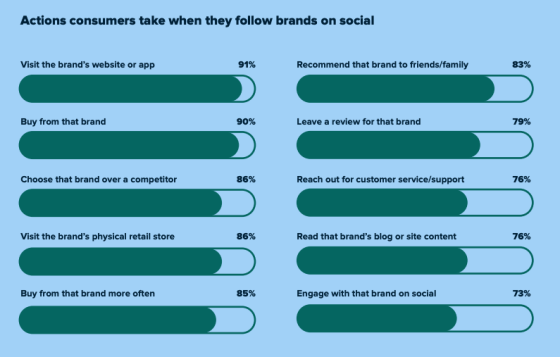
|
|
Image adapted for email from Sprout Social source
|
| |
It does have data on what users do who follow your property, however. This is a bit of a tautology in that yes, people who follow your property are more engaged, so they take more actions. Don't think that a Page Like campaign would produce similar results. |
—
Read the full story from Sprout Social |
| |
|
|
|
|
| |

|
| |
| Market Research |
| Patients want engagement |
| Source: TalkDesk |
A new report from TalkDesk looks at what patients want. To summarize they want attention. Patient support programs need to actually listen to their audience and reply. |
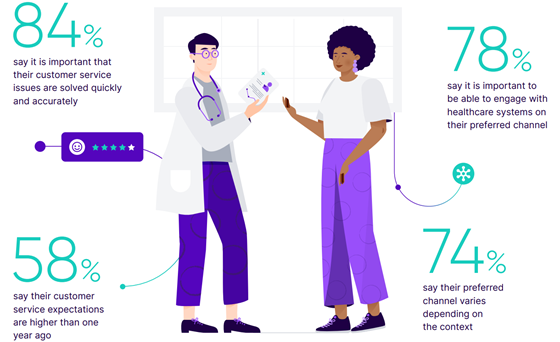
|
|
Image adapted for email from TalkDesk source
|
| |
When looking at these support programs don't forget the patients themselves. Don't dump them into an impersonal form, make sure your telephone and digital contact points meet their expectations and only ask for the information you plan on acting on. |
—
Read the full story from TalkDesk |
| |
|
|
|
|
| |